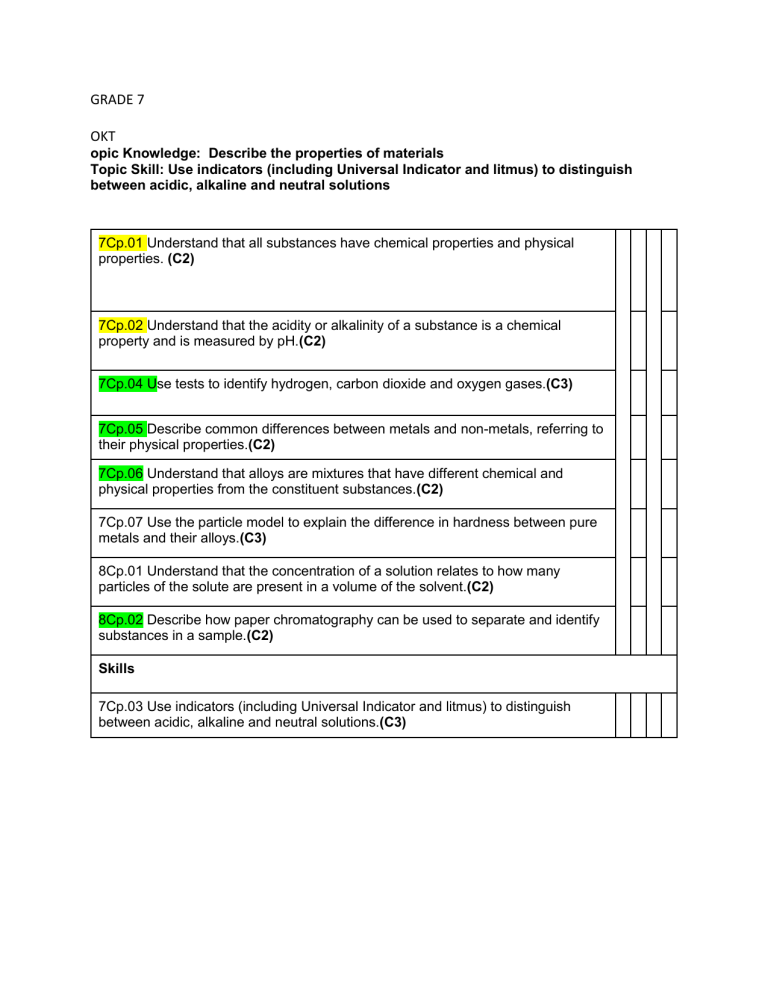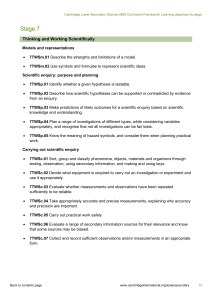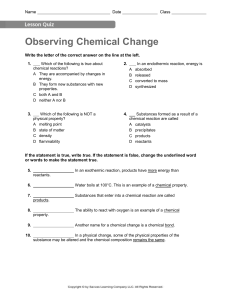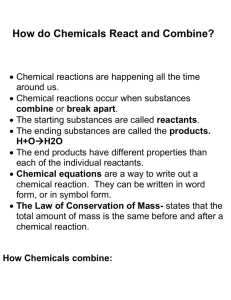
GRADE 7 OKT opic Knowledge: Describe the properties of materials Topic Skill: Use indicators (including Universal Indicator and litmus) to distinguish between acidic, alkaline and neutral solutions 7Cp.01 Understand that all substances have chemical properties and physical properties. (C2) 7Cp.02 Understand that the acidity or alkalinity of a substance is a chemical property and is measured by pH.(C2) 7Cp.04 Use tests to identify hydrogen, carbon dioxide and oxygen gases.(C3) 7Cp.05 Describe common differences between metals and non-metals, referring to their physical properties.(C2) 7Cp.06 Understand that alloys are mixtures that have different chemical and physical properties from the constituent substances.(C2) 7Cp.07 Use the particle model to explain the difference in hardness between pure metals and their alloys.(C3) 8Cp.01 Understand that the concentration of a solution relates to how many particles of the solute are present in a volume of the solvent.(C2) 8Cp.02 Describe how paper chromatography can be used to separate and identify substances in a sample.(C2) Skills 7Cp.03 Use indicators (including Universal Indicator and litmus) to distinguish between acidic, alkaline and neutral solutions.(C3) 1. NOV Topic 5: Changes to materials Topic Knowledge: Describe the chemical reaction Topic Skill: Use word equations to describe reactions 7Cc.01 Identify whether a chemical reaction has taken place through observations of the loss of reactants and/or the formation of products that have different properties to the reactants (including evolving a gas, formation of a precipitate, or change of color). (C4) 7Cc.02 Explain why a precipitate forms, in terms of a chemical reaction between soluble reactants forming at least one insoluble product.(C2) 7Cc.03 Use the particle model to describe chemical reactions.(C3) 7Cc.04 Describe neutralisation reactions in terms of change of pH.(C2) 8Cc.02 Know that some processes and reactions are endothermic or exothermic, and this can be identified by temperature change. (C2) 8Cc.03 Describe the reactivity of metals (limited to sodium, potassium, calcium, magnesium, zinc, iron, copper, gold and silver) with oxygen, water and dilute acids. (C2) 8Cc.04 Know that reactions do not always lead to a single pure product and that sometimes a reaction will produce an impure mixture of products. (C2) 8Cc.05 Describe how the solubility of different salts varies with temperature.(C2) 8Cc.06 Understand that some substances are generally unreactive and can be described as inert.(C2) Skill 8Cc.01 Use word equations to describe reactions. (C3)




